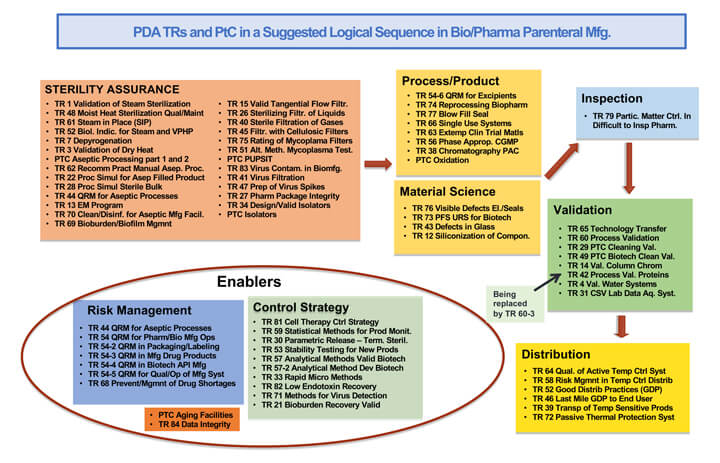The Complex Process for Sterile Filling and Points to Consider
The PDA publications portal is an incredible resource. The portal contains links to technical reports (TRs), points to consider (PtC) documents, PDA JPST articles, the PDA Letter and the PDA Bookstore. Moreover, members of these publications make consistent use of technical know-how TRs and PtCs, which are only available through membership. To better understand and leverage all the available material, we prepared an affinity map to assign each TR and PtC a category (see Figure 1).
A critical review of the groupings and their contents showed that we did not have a specific document focused on the technology of sterile filling. While there were documents addressing aseptic practices and sterility assurance controls, there was nothing specific to the equipment and process of getting a product into a sealed container–closure system. The filling process step has many requirements to be met, including:

- Ensuring introduction of sterile materials and maintaining sterility during their manipulation
- Avoiding degradation of product or alteration of the formulation (e.g., free radicals, leachables, oxidation, oxygen-sensitivity, adsorption, temperature sensitivity and light sensitivity)
- Delivering appropriate dose control and homogeneity of formulations
- Minimizing particle-generation and related product contamination
- Safeguarding appropriate sealing of containers to protect product from microbial and/or gas ingress
- Ensuring that given container–closure platforms are assembled to meet given functional and aesthetic requirements
These requirements immediately reveal the inherent complexity of the filling process and its critical influence on the quality of the final product. To add to this complexity, filling processes must be capable of delivering a wide variety of product target profiles:
- Single dose or multidose
- Liquid solution, liquid suspension, powder and lyophilized with their associated filling technologies
- Variable dose size (from fractional milliliters to liters)
- Different platforms, including vials, cartridges, syringes, ampoules, bottles and bags
- Different environments for filling, including standard aseptic processing to RABS to isolators
Leveraging our combined 60+ years of experience in the pharmaceutical industry, we developed an extensive table of contents, prepared a charter for the points to consider and gained the approval of the PDA Scientific Advisory Board in late summer of 2022. Unfortunately, the timely publication of EU GMP Annex 1: Manufacture of Sterile Medicinal Products impeded our efforts to kick off the work.
Julius Caesar said, “Alea Iacta est.” Translated, this means that a course of action has been finalized, which is fitting because a list of highly qualified pharmaceutical/biopharmaceutical companies and suppliers of equipment and components were assembled. Throughout this process, team members were selected to ensure that the team consisted of individuals who possessed the know-how to list the final points to be considered in the document.
The team has been successful in getting the right participants and driving highly active participation in the initial drafting of the document contents. We established smaller task forces to work on individual chapters according to each member’s area of expertise and interest. And, through the extraordinary efforts of our PDA project manager, Jessie Lindner, who helps keep us on track, we have structured a document repository where we can write and review the chapters of the PtC.
The current timeline indicates that the final document may be ready to publish by the end of 2023.
Feedback and participation from all team members have been very good, exactly in line with PDA’s motto, “connect people, science and regulations.” All sections of the outline now have a working draft. A big push to complete drafts before the close of 2022 was successful, thanks to the diligence of the whole team. Working together and sharing our knowledge is extremely rewarding and contributes to our own development. We trust that the final product will prove to be a useful reference for the industry, suppliers and regulators for years to come.



 Mauro Giusti has worked with Eli Lilly for
32 years in pharmaceutical manufacturing in a variety of roles—technical services, regulatory, quality, operations and project managment—including five years abroad in the United States and the UK on assignments. He currently is Advisor for Site
External Network at Lilly Italia, keeping contact with schools, universities and professional associations and providing oversight for development of technical capabilities at Lilly Parenteral Products Network. Giusti holds a master’s degree in
chemistry and has been certified as a Qualified Person by the Italian Ministry of Health. Part of the PDA Italy Chapter for the last 15 years, Giusti is currently co-chair of the PDA Process Validation Interest Group and a member of the PDA Science
Advisory Board.
Mauro Giusti has worked with Eli Lilly for
32 years in pharmaceutical manufacturing in a variety of roles—technical services, regulatory, quality, operations and project managment—including five years abroad in the United States and the UK on assignments. He currently is Advisor for Site
External Network at Lilly Italia, keeping contact with schools, universities and professional associations and providing oversight for development of technical capabilities at Lilly Parenteral Products Network. Giusti holds a master’s degree in
chemistry and has been certified as a Qualified Person by the Italian Ministry of Health. Part of the PDA Italy Chapter for the last 15 years, Giusti is currently co-chair of the PDA Process Validation Interest Group and a member of the PDA Science
Advisory Board. Rebecca Brewer is the Strategic Practice
Lead at Quality Executive Partners where she works with customers to promote good aseptic practices and controls. She is a member of the PDA Scientific Advisory Board and the Advanced Therapy Medicinal Products Advisory Board. Brewer is the co-lead
for the Sterile Processing Interest Group as well as the newly formed Annex 1 Interest Group. She serves as an instructor for PDA and ISPE and is currently participating in PDA task forces updating the technical report for phase-appropriate GMPs
and developing points-to-consider documents for both viral vectors and sterile filling.
Rebecca Brewer is the Strategic Practice
Lead at Quality Executive Partners where she works with customers to promote good aseptic practices and controls. She is a member of the PDA Scientific Advisory Board and the Advanced Therapy Medicinal Products Advisory Board. Brewer is the co-lead
for the Sterile Processing Interest Group as well as the newly formed Annex 1 Interest Group. She serves as an instructor for PDA and ISPE and is currently participating in PDA task forces updating the technical report for phase-appropriate GMPs
and developing points-to-consider documents for both viral vectors and sterile filling.